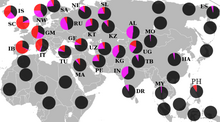| Haplogroup R1 | |
|---|---|
 | |
| Possible place of origin | Siberia, Central Asia, South Asia or Southwest Asia[1][2][3] |
| Ancestor | R (R-M207) |
| Descendants | R1a (M420), R1b (M343) |
| Defining mutations | M173/P241/Page29, CTS916/M611/PF5859, CTS997/M612/PF6111, CTS1913/M654, CTS2565/M663, CTS2680, CTS2908/M666/PF6123, CTS3123/M670, CTS3321/M673, CTS4075/M682, CTS5611/M694, CTS7085/M716/Y481, CTS8116/M730, F93/M621/PF6114, F102/M625/PF6116, F132/M632, F211/Y290, F245/M659/Y477, FGC189/Y305, L875/M706/PF6131/YSC0000288, L1352/M785/YSC0000230, M306/PF6147/S1, M640/PF6118, M643, M689, M691/CTS4862/PF6042/YSC0001281, M710/PF6132/YSC0000192, M748/YSC0000207, M781, P225, P231, P233, P234, P236, P238/PF6115, P242/PF6113, P245/PF6117, P286/PF6136, P294/PF6112, PF6120[4] |
Haplogroup R1, or R-M173, is a Y-chromosome DNA haplogroup. A primary subclade of Haplogroup R (R-M207), it is defined by the SNP M173. The other primary subclade of Haplogroup R is Haplogroup R2 (R-M479).
Males carrying R-M173 in modern populations appear to comprise two subclades: R1a and R1b, which are found mainly in populations native to Eurasia (except East and Southeast Asia). R-M173 contains the majority of representatives of haplogroup R in the form of its subclades, R1a and R1b (Rosser 2000, Semino 2000).
- ^ Kivisild 2003
- ^ Soares 2010
- ^ (Wells 2001) [dead link]
- ^ Y-DNA Haplogroup R and its Subclades – 2008 from ISOGG